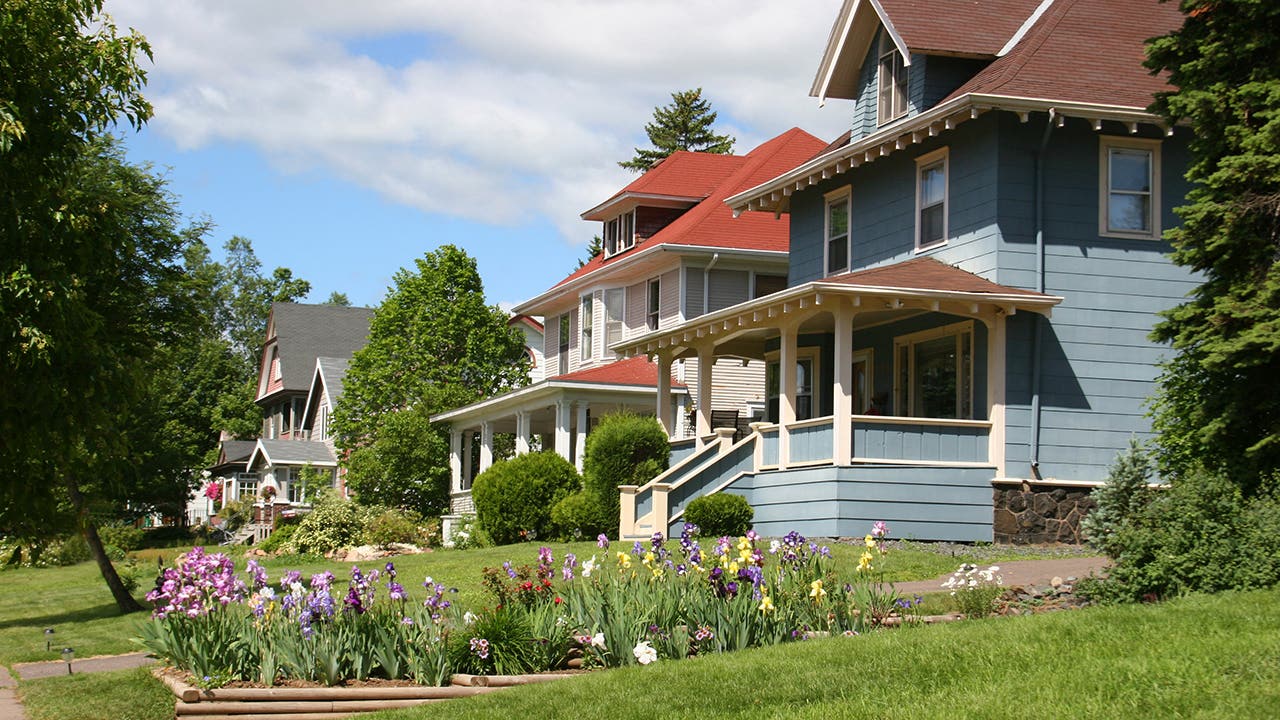Buying a house in Minnesota: A how-to

The Bankrate promise
At Bankrate we strive to help you make smarter financial decisions. While we adhere to strict , this post may contain references to products from our partners. Here's an explanation for .
If you’re looking to buy a house in Minnesota, the latest data from Minnesota Realtors has some good news: The number of homes for sale increased by more than 6 percent between July 2021 and July 2022. And while the median sale price in the state has increased to $339,900, that’s still quite a bit more affordable than the national median sale price of $389,500.
However, don’t let the figures fool you into thinking that buying a home in Minnesota is easy. This is still a seller’s market, with homes selling for around 1 percent above their asking price. With that in mind, you’re probably trying to answer a tough question: Should you buy a house now or wait? If your credit is good and you want to stay in Minnesota for a long time, there’s no reason to delay your purchase any longer. Rental costs are rising, so why not put that money toward a place of your own? Read on for everything you need to know about buying a house in Minnesota.
How to buy a house in Minnesota
Decide where to live in Minnesota
From big, booming Minneapolis (one of Bankrate’s best places to live in 2022) and its twin city, St. Paul, to the remote calm of Canada-bordering Baudette, there’s a wide range of places to consider calling home here. In addition to the cost of the house you’re going to buy, make sure to do your research on how to budget for the rest of your essential expenses, too. The cost of living will look different depending on where you plant your roots; the Minnesota state government offers a helpful county-by-county rundown. Your dollars will stretch a lot further in Winona County, where the annual cost of living adds up to $47,365, than they will in Washington County, where the cost of living is more than $20,000 higher.
While you’re focused on the present, be sure to think about the future, too. Buying a home anywhere includes a lot of one-time costs, so you should try to avoid moving and buying another one anytime soon. It doesn’t have to be a forever home, but it should certainly last you longer than a couple of years.
Tips for buying a house in Minnesota
Before you start comparing mortgage rates in Minnesota, it’s important to have an idea of what kind of home you’re looking to buy — and how much money you’ll need to borrow to make it happen. Across the entire state, the conforming loan limit in 2022 is $647,200. If you want to borrow more than that amount, you will need to apply for a jumbo loan. Those require higher credit scores and larger down payments.
Things to know about buying a house in Minnesota
- Property taxes: Be sure to ask for the most recent property tax bill from any home you’re thinking about buying to get a sense of what you’ll need to pay the government each year. According to the Tax Foundation, Minnesota property owners pay 1.1 percent of their property’s assessed value (not the sale price) in taxes.
- Dual agency: Dual agency is legal in Minnesota, which means that your real estate agent, or an agent from their same brokerage firm, might also represent the seller in a transaction. This can create a potential conflict of interest, so you’ll want to think carefully about whether you’re OK with the arrangement. If you are, you and the seller will need to sign a written consent form.
- Seller’s disclosure: In Minnesota, most sellers complete a property disclosure form outlining any defects that could impact the property. However, unlike in most other states, here there are two other options: The buyer can opt to review a home inspection report instead, or the buyer can waive the disclosure form entirely.
- Closing costs: In 2021, the average closing costs on a Minnesota home purchase added up to $4,011, according to Core Logic’s ClosingCorp. However, the seller is responsible for some expenses, such as the deed tax. Additionally, you may be able to negotiate for the seller to cover the cost of a title insurance policy.
- Attorneys: Homebuyers are not required to hire a real estate attorney in Minnesota — but you should strongly consider paying for one anyway. Buying a home includes sifting through a mountain of paperwork, parsing confusing contract language and paying a lot of money. A legal expert is an invaluable asset.
- Climate and weather considerations: Between the mighty Mississippi River and the 10,000 lakes (actually, there are 11,842 lakes, but who’s counting?), Minnesota has a lot of shorelines. While they look beautiful, they also pose a risk of flooding to around 13 percent of all properties here. Depending on where you’re looking to buy, you may want to pay for additional flood insurance coverage to make sure your home is protected in a worst-case scenario.
How much house can I afford in Minnesota?
Setting a budget for buying a home in Minnesota involves a range of inputs: how much you’re going to put down, how much you earn, how much you have to pay to cover other debts each month, how long you’re planning for your mortgage term and more. You don’t need to use a spreadsheet to sort through the maze of mathematics, though. Bankrate’s new-home calculator can help you understand what a lender is likely to allow in terms of a maximum monthly mortgage payment.
As you think about whether you should buy a house now, remember that you’ll need to plan for the recurring costs of homeownership, too, including the ability to cover unexpected repairs. If your furnace goes out in the middle of a Minnesota winter, you won’t want to wait until you can afford a replacement.
Saving for a down payment in Minnesota
If you’re a first-time homebuyer or you’re getting by on a low income, this first piece of the financial puzzle of buying a home can feel especially daunting. Fortunately, there are options for down payment assistance to help make the dream of owning a home a reality. The Minnesota Housing Finance Agency offers a couple of options to borrow cash for your down payment and closing costs: one that charges interest, which you must pay back over a period of 10 years, and another that does not charge any interest and defers your payments until you pay off your mortgage, refinance or move. You’ll need to earn less than a certain amount of annual income, depending on the size of your household and where you’re buying.
Get preapproved for a mortgage
Once you have an idea of your down payment and your total homebuying budget, it’s time to get preapproved for a mortgage. This involves sharing a look at all your streams of income with a lender, who will also review your credit to determine if their company is likely to loan you the cash. Some lenders can issue preapprovals really fast — 15 minutes or less online — and others might take a couple of days. Either way, preapproval lets a seller know that you have already laid the foundation for financing, and they can feel reasonably confident that you will be able to close the deal.
Find the right lender
When you’re ready to get the “pre” removed from your status as a borrower, you don’t necessarily have to go with the company that issued your preapproval. Every mortgage company is different, offering a unique set of terms, rates and closing costs. Make sure you compare the APR attached to offers from each lender, which represents the full cost of your loan. You’ll also want to ask how quickly each lender can close and if they offer any special benefits, such as an on-time closing guarantee or discounts for using other services.
Find the best local real estate agent in Minnesota
A real estate agent plays an essential role if you’re buying a home in Minnesota. With limited inventory available, an agent’s understanding of the local market can help point you to listings you might not otherwise find. And if you’re planning to move to Minnesota from somewhere else, an agent is even more crucial: Buying a house from out of state can be really stressful, but an on-the-ground agent can act as your eyes and ears if you can’t get there in time to see a new property.
House-hunting and making an offer
When you start house-hunting, go into the search with an open mind about what you must have and what you’ll be able to live without — at least initially. For instance, let’s say you find a home with an outdated kitchen that is $40,000 under your budget. If you love everything else about it, can you deal with the 1970s culinary vibe for a bit before investing in a renovation?
When you find a house that you want to make a home, your real estate agent will help you determine how to craft a compelling offer. For example, homes in the Twin Cities were selling for more than 1.5 percent more than their asking price in July, so a lowball offer might turn off a seller. The story is different in the Upper Minnesota Valley, though. Homes there have been selling for 6 percent below their list price, so you may have a bit more bargaining power.
Get a home inspection and appraisal
When your offer is accepted, you’ll feel the rush of getting closer to homeownership. Not so fast, though. Get a home inspection to make sure there are no major defects — a roof that’s about to need replacing or water damage in the basement, for example.
In addition to a home inspector checking out the place, your lender will require an appraiser to visit it, too. The appraiser will assess the market value of the home. It’s a way to help reassure the lender that the price you’ve agreed to pay (with their cash) is accurate. Then, if you ever default on the loan, the lender can recoup their losses by selling it.
Final walk-through and closing on your new Minnesota home
After the professional expertise of an inspector and appraiser, there’s room for one amateur opinion: yours. Ask your agent to schedule a final walk-through shortly before closing to double-check that the seller has removed all their belongings and that nothing has been damaged in the process. Follow this checklist to make sure you don’t miss anything.
If you’re satisfied, it’s time to head to your closing. Take a cashier’s check to cover all your costs, proof that you’ve paid for homeowners insurance, a government-issued photo ID and a list of all your addresses for the past 10 years. Then, be ready to sign your name on a large stack of papers so you can get a brand-new address. Congrats! You’re officially a Minnesota homeowner.
FAQs
-
The Minnesota Housing Finance Agency offers programs for first-time homebuyers that can help you qualify for a mortgage that will let you make a down payment of just 3 percent of the purchase price. You can also apply for loans that will help you cover the down payment and closing costs. There are a few key conditions you’ll need to satisfy: Have a minimum credit score of 640, be able to contribute at least $1,000 of your own money and earn an annual income that does not exceed certain limits, based on the county where you’re buying. Additionally, you will likely need to complete a homebuyer education course.
-
If you’re applying for a conventional loan, you may be able to qualify with a credit score as low as 620. However, the best mortgage rates are reserved for borrowers with higher credit — 740 and above. If your credit is lower, you may want to explore FHA loans. Some lenders may approve credit scores as low as 500, but you will need to make a down payment of at least 10 percent of the purchase price.
-
Conventional loans will require a minimum down payment of 3 percent of the purchase price. If you’re looking to buy a home in the Twin Cities area, where median sale prices are $375,000, you would need at least $11,250. In the Northwest region, however, median sale prices are just $166,950, meaning you might be able to put just over $5,000 down. Most people make much larger down payments in Minnesota, though. As of March 2022, the median down payment on a home in the state was $38,000.
Related Articles



